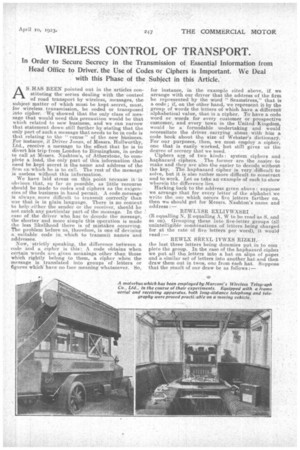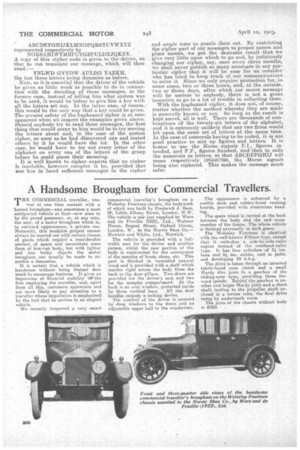WIRELESS CONTROL OF TRANSPORT.
Page 15

Page 16

If you've noticed an error in this article please click here to report it so we can fix it.
In Order to Secure Secrecy in the Transmission of Essential Information from Head Office to Driver. the Use of Codes or Ciphers is Important. We Deal with this Phase of the Subject in this Article.
AS HAS BEEN pointed out in the articles constituting the series dealing with the control of road transport by wireless, messages, the subject matter of which must be kept secret,, must, for wireless transmission, be coded or transposed into cipher. We showed that the only class of message that would needthis precaution would be that which related to new business, and we can narrow that statement down still further by stating that the only part of such a message that needs to be in code is that relating to the " venue" of the new business. For instance. if Driver Jones, of Messrs. Hullworthy, Ltd., receive a message to the effect that he is to divert his trip from London to Birmingham, in order to call at Messrs. Nashton's, of Atherstone, to complete a load, the only part of this information that need be kept secret is the name and address of the firm on which he is to call. The rest of the message is useless without this information.
We have laid stress on this point because it is obvious that, flQ far its possible, as little recourse should be made to codes and ciphers as the exigencies of the business in hand permit. A code Jilessage is always more difficult to transmit correctly than one that is in plain language. There is no context to help either the sender or, the receiver, should he not catch any particular part of the message. In the ; case of the driver who has to decode the Message, the shorter and more simple this operation is made the less likelihood there is of mistakes occurring. The problem before us, therefore, is one of devising a suitable code in, which to transmit names and addresses.
Now, strictly speaking, the difference between a code and a cipher is this: A code obtains when certain words are. given meanings other than those which rightly belong to them, a cipher .when the message is translated into groups of letters or figures which have no face meaning whatsoever. So,
for instance, in the example cited above, if we arrange with our driver that the address of the firm be represented by the word " Seamstress," that is a code ; if, on the other hand,. we represent it by the group of words the letters ofwhich have a different alphabetical value, that is a cipher. To have a code word or wards for every customer or prospective customer, and every townin the UnitedKingdOni, would be a• formidable undertaking and would necessitate the driver carrying about with him a code book about the size of Weaster's dictionary.' For our purposes, then; we must employ a cipher, one that is easily worked,. but still gives us the
degree of secrecy that we need. Ciphers are of two kinds : system ciphers and haphazard ciphers. The former are the easier to make and they are also the easier to decode without the key. The haphazard eiPher is very idiffic•ult to solve, but it is also rather more difficult to construct and to work. Let us take an example of each to show wherein the difference lies. .
Harking back to the address given above : suppose we arrange that for every letter of the alphabet-we write the one which occurs five letters farther on, then we should get for Messrs. Nashton's name and address :—
REAVL X SR EXLIVWX SRI
(R. equalling N, E equalling A. W to be read as 5, and so on). Grouping these into five-letter groups (all unintelligible combinations of letters being charged for at the rate Of five letters per Word), it would read:—
REWLX SREXL -IVWXS RIZKH,the last three letters being dummies pet in to coin plete the group. In the ease of the haphazard ciphei we put -all the Jetters into a hat on slips of panel and a •similar set of letters into another hat and then draw them out in twos, one from each hat, Suppose that the _result of our draw be as follows AB ODE F GHIJKLMNOPQRST UVWXY represented respectively by NORSAHI WTMBPCYGZFULDXJQICEV. A copy of this cipher code is given to the driver, so that he can translate our message, which will then read :— YNLWD GYNDW AULDG YAZIcH, the last three letters being dummies as before. Now, as it is essential that the driver of the vehicle be given as little work as possible to do in connection with the decoding of these messages, in the former case, instead of telling him what system was to be used, it would be better to give him a key with all the letters set out. In the latter ease, of course, this would be the only way that a key could be given. The greater safety of the haphazard cipher is at once apparent when we inspect the examples given above. Should anybody try to read these messages, the first thing that would occur to him would be to try moving the letters about and, in the ease of the system cipher, so soon as he had discovered one and tested others by it he would have the lot. In the other case, he would have to try out every letter of the alphabet on every one of the letters of the group before he could guess their meaning. It is well known to cipher experts that no cipher is insoluble, however complex it be, provided that one has in hand sufficient messages in the cipher
and ample time to puzzle them out. By restricting the cipher part of our messages to proper names and place names, we get the desirable result that we give very little upon which to go and, by judiciously changing our cipher, say, once every three months, We shall never publish so many messages in any particular cipher that it will be easy for an outsider who has tried to keep track of our communications to solve it. Since we only require protection for, in some cases, two or three hours, and, at the outside, two or three days, after which our secret message will be useless to anybody, there is not a, great incentive to go to a lot of trouble in collecting them.
With the haphazard cipher, it does riot, of course, matter whether the method whereby they are made is generally known or not. So long as the result is kept secret, all is well. There are thousands of combinations of the twenty-six letters of the alphabet, and it is extremely unlikely that any two firms would. hit upon the same set of letters at the same time. In the case of numerals having to be coded, it is not goad practice to mix up figures and letters. It is !better to Use the Morse sipials F.I., figures intended, and RE, figures finished, and then to code the numerals as letters, so that ABCDEFGHIJ will mean respectively 1234567890, the Morse signals being also ciphered. This -makes the message much safer.






























